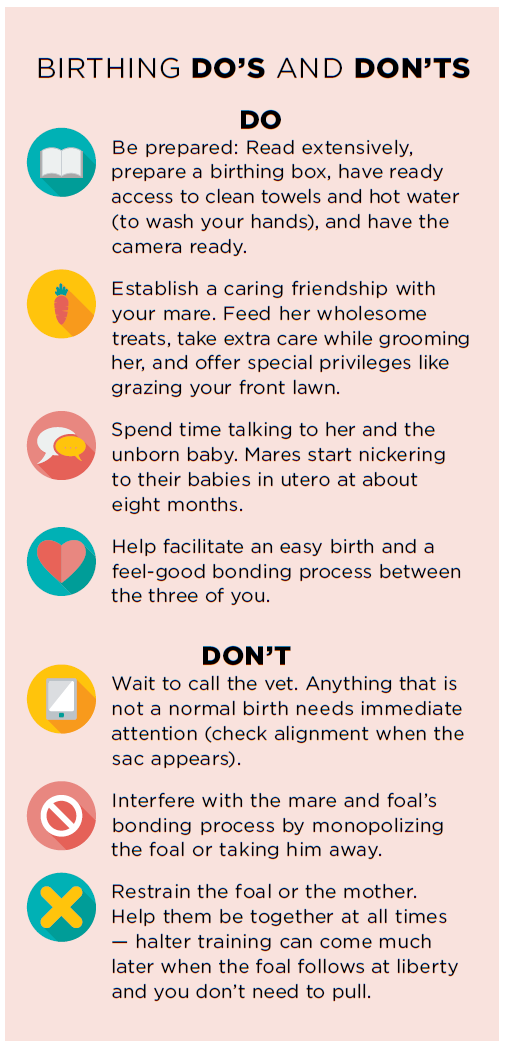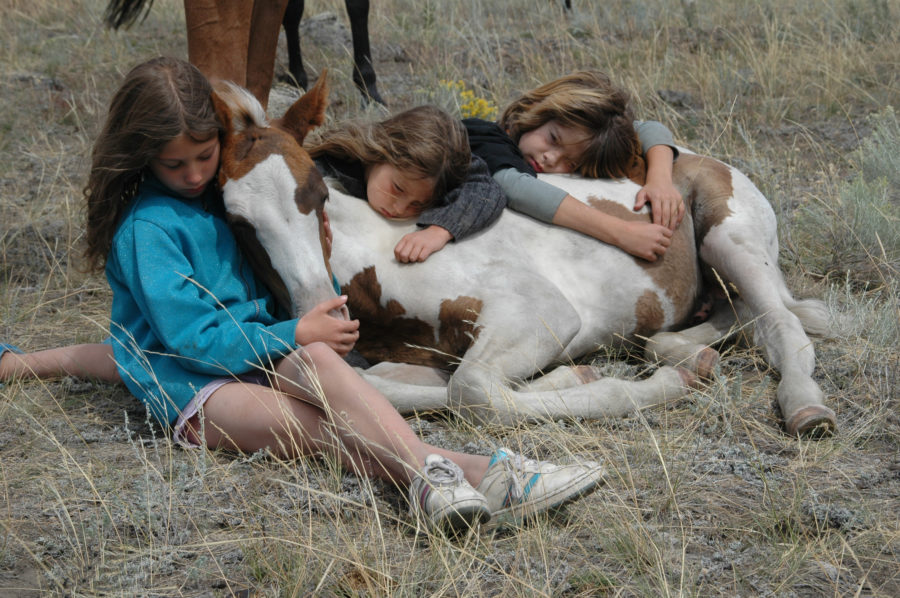Non-invasive imprinting means learning how to be the best birth coach a mare could hope for, and introducing her foal to a world of love, support and harmony with humans.
I am always refining and enhancing my connection and communication with horses, so I read everything I can get my hands on. I specifically remember when Dr. Robert Miller published his findings on imprinting, to the snickers of the “old boys” club. His practices are now embraced by natural horsemanship greats like Pat Parelli, and adhered to religiously by most breeders.
As a Warmblood breeder for 20 years, I have birthed and raised dozens of foals (visit youtu.be/4TodnCE5FVg where I share what I’ve learned). Over time, I have developed a more holistic and rewarding approach to the imprinting process – an approach that’s more in line with how we welcome humans into the world.
Loving and non-invasive imprinting has several key concepts. Let’s take a closer look.
Be a trusted and considerate friend to your mare
In order for your mare to welcome you at the birth of her foal, and to trust you with her well-being, she must first consider you a true friend. This is a lifelong process, but a simple lead-in is to be genuinely considerate – to be as kind and generous as you would be to a human friend.
One of the best ways to a mare’s heart is through her stomach. Make a fuss over her condition by preparing wholesome healthy meals and snacks. This will have her nickering the minute she sees you. Grooming, scratching, and forays to find choice patches of succulent grass are also great bonding exercises.
All of this is time well spent, as your mare will transfer her feelings about you to her new foal. Animals learn by example, so in turn, the foal will watch his mother closely to see how she responds to her human caregiver.
In order for your mare to welcome you at the birth of her foal, and to trust you with her well-being, she must first consider you a true friend.
Learn all you can about foaling
This is essential in order to be able to make wise safety decisions. Find a reliable and comprehensive book on the care of mares and foals throughout the birthing period. I recommend two books by M. Phyllis Lose, VMD, Blessed are the Brood Mares and Blessed are the Foals (available on Amazon). Study diligently to become more confident, so you can recognize when all is normal and when to call a vet. If you don’t know what to look for, you won’t be able to help your mare or her new foal if problems arise. Horses birth quickly and efficiently unless there is a misalignment, so it’s crucial that you know how to step in if needed.
Help make the birthing experience go smoothly
Be there for your mare when she is birthing, and help make it easier for her. Because my mare knows her well-being is everything to me, she welcomes me at the birth.
When her water breaks and the sac appears, I immediately check the position of the foal. In a normal birth, one foot is presented slightly ahead of the other, soles down. If it is any other way, make an emergency call to your vet! Holding the foal’s front pasterns and pulling gently and rhythmically towards the belly with the mare’s contractions will help her labor proceed more easily. When the foal’s nose appears, break the sac so the baby can breathe.
If all goes smoothly, birth usually occurs about 20 to 30 minutes after the water breaks.

Be sensitive and gentle
Imprinting can be loving and helpful, rather than disruptive and invasive. Harsh imprinting methods recommend taking the baby away from its mother at birth and performing a series of extreme de-sensitizing exercises. These exercises, like tapping the soles of the foal’s feet hundreds of times, or sticking fingers in all his orifices, are designed to deaden his reaction to simple procedures like trimming and shoeing, or veterinary treatment. Electric clippers, plastic bags – the list goes on and on. These brutish practices form the baby’s first impression of the world while his mother is restrained and not allowed to welcome her own baby.
In my barn, the foal is towel dried and loved. I kiss and congratulate the mare until she or the foal breaks the umbilical cord. I then help the foal get close to the recovering mom so she can lick all the places I have just dried. Afterward, the two of us alternate in one big welcome fest!
The mare then rises and I clip her placenta back up to itself (squeeze clamps from the hardware store work well) so she won’t step on the trailing end and tear it. It is the weight of the placenta that helps it separate cleanly from the uterine wall without leaving bits that can cause serious infection. Though it might seem tempting, don’t attempt to pull it off yourself!
During this time, the baby will be attempting to stand. When he succeeds, he will then begin the search for his mother’s udder. It is better to give him time (up to two hours) to find it on his own – most mares will try to help by getting in position and pushing the foal in the right direction.
My lead mare, Limited Edition, is a master at this. She curves her body around the foal and pushes his hind end with her nose. If your mare needs a little extra help and is open to it, you can gently guide the foal to the general area.
Don’t dominate or force the foal
As Pat Parelli says, “take the time it takes”. Gently and considerately get to know the foal. Prove to him that your concern is for his comfort and safety. Talk gently, praise him, and don’t be in a hurry to restrain him. You’ll see the proof is in the pudding, as I did with Paschar, the foal in the photos shown below.

Paschar was born three weeks early after Epona, his mom, had a serious bout of pneumonia. The vets suggested we abort the ten-month-old fetus as the mare was having trouble breathing. But Epona and I agreed that our baby would live! When Paschar was born, he was literally fighting for his life, and even after my gentle welcome, he tried to rear and run at me a day later. I understood his concern; humans had wanted to end his life and he had to fight for it. I patiently talked to him and told him he was my angel (he’s named after Paschar, the angel of vision) and as I talked and stroked him, his eye softened and he relaxed.
Days became weeks, and I constantly reminded Paschar who he was and how loved he was. Each time, his eye grew softer. By the time he was two months old, he was the most gregarious, loving and affectionate foal, and particularly loved being buried under hugging children. At three months old, he followed at liberty, backed, moved his hind end and shoulder, picked up his feet, trailer loaded (all at liberty), and ran happily behind me in a game I call “stick (to me)”. He was fully imprinted and de-sensitized while filled with life and joy.
By two years old, Paschar understood my every word. He was so self-assured that he followed me down to our playground several hundred yards from the paddock where his family was grazing, and got up on tires, ran across bridges, walked, trotted and “whoaed” all through the use of voice and body language, without halters, ropes or sticks.
Paschar is a super horse. Why? He was born gently, loved, treated with patience and consideration. There is no question in his mind that his well-being is my first concern.







